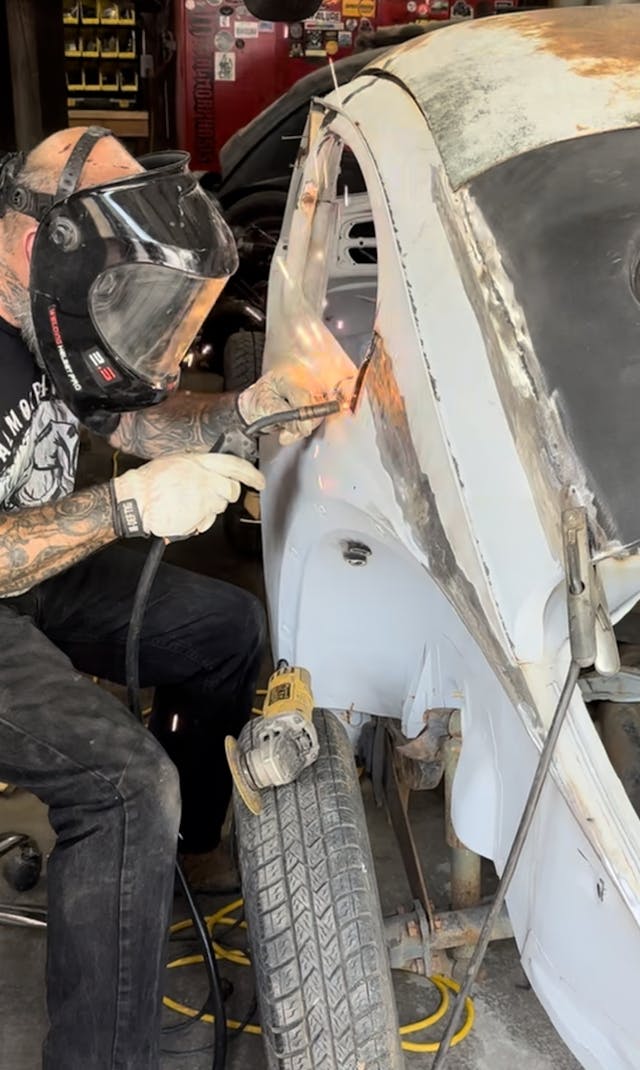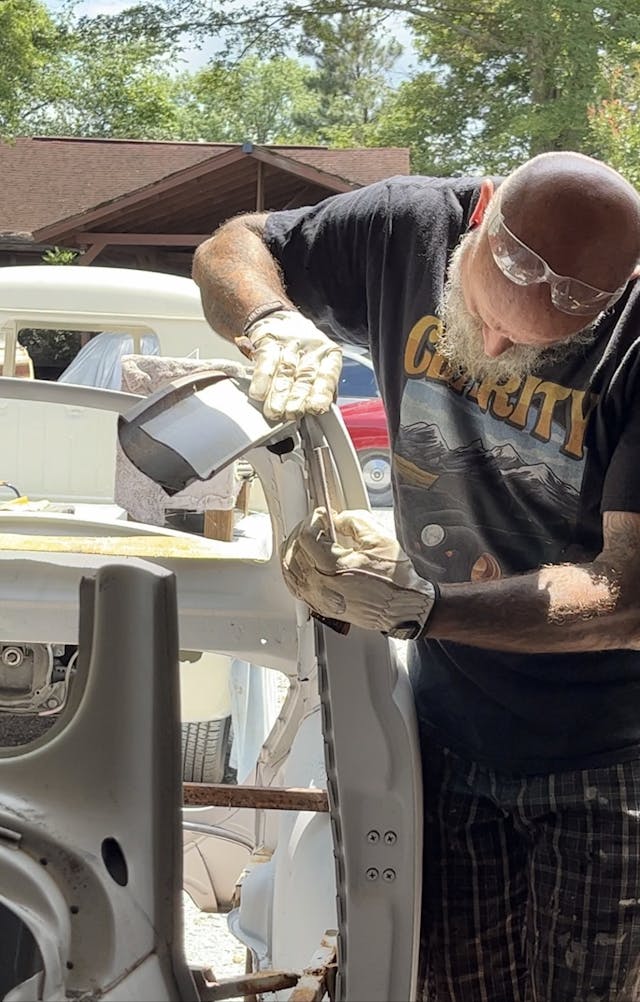Media | Articles
Vintage VWs Brought, and Kept, This Hot-Rodding Couple Together
Detroit Autorama is one of the country’s most prestigious shows for custom cars. Ever since 2002, the builds that win the show’s top trophy, The Don Ridler Memorial Award, are cost-no-object extravagances that run into the seven figures. But not everyone in Huntington Place this year had such budgets, or ambitions. Many of our favorite customs were built—and owned—by part- or full-time craftspeople who often did the work on their off-hours, funding it through day jobs that might or might not have anything to do with the automotive industry. Several were first-time Autorama attendees. The presence of these people and their builds brings a calmness to the show that you’ll miss if you judge it only by the winner of “the Ridler.”
Rodney and Cate Culp are an unlikely pair. Until six years ago, they didn’t know each other existed: He was in Alabama, she in Australia. Their mutual love of Volkswagens, and Instagram, brought the two together right before Christmas of 2017. She came to the states a month later, after a fire decimated Rodney’s shop, leaving him with nothing more than a slab of concrete. Two years later, they married. Together with one other technician, they represent Metalmorphosis Customs, a shop out of Danville, Alabama, that specializes exclusively in air-cooled Volkswagens—built however Rodney and Cate want them to be built.

An unusual business model and an attitude of contentment give the pair room to exercise their “full creative spectrum,” as Cate puts it. “We don’t do any client work anymore,” she says. She wears her long, graying hair streaked with dark purple. (Per her TikTok profile, it’s usually pink.) “We just build cars to sell. We usually do about three or four builds a year: We do one giveaway, and then we sell the other three, and hopefully [we] make enough money to live off.”




This chopped 1967 Beetle, dubbed Audacity, is one of those cars, given away at random to someone who has donated MetalMorphosis Charitable Foundation. Its mission is to minimize the effects of human trafficking by funding education, housing, health, and safety for severely underprivileged children. Audacity is already spoken for: A winner was chosen in November, and the Culps are taking the car on the show circuit before delivering it to the new owner in May. The next two giveaway builds are Lhia, a lilac Karmann Ghia that is scheduled to be completed by the end of this month and will be raffled off on December 20; and Maggie, a ’66 Beetle that will be completed in November of ’26 and won by a lucky donor on December 20 of that year.
Metalmorphosis sells its cars not through some established broker but through social media: TikTok or Instagram, where they have 350,000 and 15,800 followers, respectively, on @cateculp and @metalmorphosiscars. Once, they sold a car within eight minutes, after posting nothing more than paint and interior samples. The success still feels unexpected: “It’s pretty crazy,” says Cate. They’ve already sold their next six builds.

Cate and Rodney work on tight deadlines: Audacity went from stock ’67 to what you see here in 193 days. Rebuilding after his shop burned down has taken time, especially since the insurance payout only covered a new building, and none of the tools: This car was painted in an inflatable booth in their backyard … in the dark. They finished the last step—successfully putting the fenders on the car so that they didn’t scrape the 18- and 20-inch wheels—at 1 in the morning. They had been awake for over 20 hours at that point, but they couldn’t rest: They, and the car, had to be in Houston, for the Houston Autorama, at 4 p.m. the next day. They loaded the car into the truck, got on the road, and arrived in Houston … at 4 p.m.


Cate: “We set up and then stood back and went, oh shit—”
Rodney breaks in, with an Alabama drawl: “We built a really cool car!”
They both laugh.


Marketplace
Buy and sell classics with confidence
This Beetle, like any of their air-cooled VW customs, is truly a collaborative effort: Cate designs the car and brings the renders to Rodney.
“She gets a stunned look on her face when I tell her no.”
“I think he’s said no to me twice in six years or something.”
“She was like, can we put 20s and 18s on it? I’m like, ‘Yup, yup, I don’t know how we’re gonna do it yet, but we’re gonna do that.’ I enjoy a challenge.”




Rodney does everything but the interior: that’s Cate, again. Though she never expected to work in the automotive world, upholstery is right up her alley: She spent about a decade in the bridal industry, and started sewing when she was eight. She figures she’s been involved in textiles for 40 or so years.
“I just love anything that has that intricate detail … I don’t miss much, you know, and anything that sort of stands out to me, or catches my eye, probably shouldn’t be there—like, it’s all got to meld together.
“Doing themed weddings and stuff like that, it gives you that mindset of making sure that everything goes together, ‘cause there’s not many people in the world that are harder to satisfy than brides.”



Building and selling their own cars is a new era for Rodney and for Cate. Though he’s been a car guy all his life, and got his first Volkswagen at age 15, he hasn’t always made a living by wrenching: For fifteen years, he was a custodian at an elementary school. When he got the chance to work at an automotive shop, he jumped at it, and continued to do his own projects on the side. When he was suddenly let go—the shop owner was getting jealous of how much work Rodney and Cate were doing at home, he thinks—the couple decided it was time to start their own thing. That was just before Covid shut down the world, and in 2020, with nothing to do, the couple built their first giveaway car—a ’63 ragtop Beetle, the first show-level build either had attempted.
“Him being let go sort of gave him the push,” Cate said, “because I don’t think he understood how talented he is.” Rodney has leaned an elbow against the pillar of the conference center, supporting his head with his hand, gazing at her while she talks, occasionally sipping a Diet Coke. At this comment, he laughs. “He is incredibly talented,” Cate continues, “and he has decades of experience, but he just didn’t have, I guess, someone to believe in him, and he didn’t have the confidence to think that he could do it for himself.”



Cate’s been self-employed most of her life, always in some creative field, so she’s at peace with the ebb and flow of the income. Though Rodney has worked on hundreds of VWs over the past 35 years, the uncertainty of self-employment is new to him. Still, they are content.
“We never did it to be rich,” Rodney says. “We just wanted to be able to do this.” He gestures at the pink Beetle.
Behind the couple, the glitz and glamour of Detroit Autorama multiplies under the lights of the conference center. The roar of the crowd flowing through the doors and throughout the show is steady and deep. The black banners posted next to each of the Great Eight finalists for the Ridler poke their heads above the roofs of the vehicles. Cate and Rodney settle back in their folding chairs, and watch the crowd, smiling.
***
Check out the Hagerty Media homepage so you don’t miss a single story, or better yet, bookmark it. To get our best stories delivered right to your inbox, subscribe to our newsletters.





























Great story, super talented couple!
thanks, duane! the people you meet are the best part of the car world.
The interiors are pretty amazing.